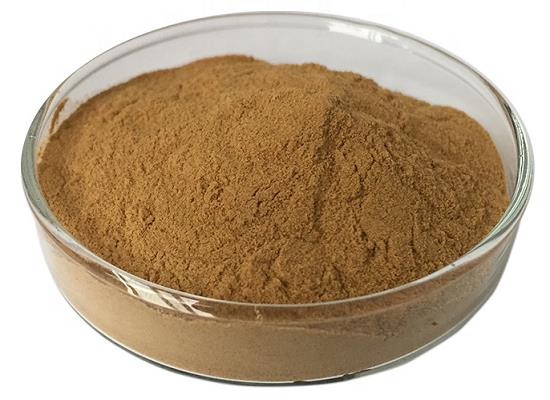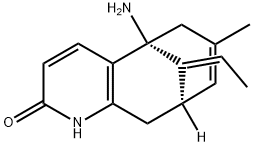(-)-Huperzine A: Clinical Applications and Mechanism of Action
General Description
(-)-Huperzine A is a naturally occurring alkaloid from Huperzia serrata, recognized for its potential in enhancing cognitive function and treating dementia, particularly Alzheimer's disease. Its primary mechanism involves the selective inhibition of acetylcholinesterase, increasing acetylcholine levels in the brain, which is crucial for memory and learning. Research demonstrates that (-)-Huperzine A offers neuroprotective effects by reducing amyloid-beta accumulation and toxicity, enhancing neurotrophic factor expression, and promoting synaptic plasticity. Clinical trials indicate significant improvements in cognitive functions among dementia patients treated with (-)-Huperzine A, which is generally well-tolerated with mild side effects. Moreover, ongoing developments in slow-release formulations aim to enhance its safety profile further. With its ability to mitigate pathological features of neurodegeneration and its favorable safety profile, (-)-Huperzine A represents a promising therapeutic option for managing cognitive decline associated with Alzheimer's disease and other dementias.

Figure 1. (-)-Huperzine A
Overview
(-)-Huperzine A is a naturally occurring alkaloid extracted from the plant Huperzia serrata, traditionally used in Chinese medicine for various ailments, including memory loss and inflammation. With its ability to effectively cross the blood-brain barrier, (-)-Huperzine A functions primarily as a selective inhibitor of acetylcholinesterase (AChE), an enzyme responsible for breaking down acetylcholine, a crucial neurotransmitter involved in learning and memory. This inhibition enhances acetylcholine levels in the brain, thereby improving cognitive function. The molecular structure of (-)-Huperzine A is notable for its complex tricyclic arrangement, which contributes to its stability and biological activity. Research indicates that (-)-Huperzine A possesses a long half-life in the bloodstream, reaching peak concentration approximately an hour after administration. Due to these properties, (-)-Huperzine A has gained attention as a potential therapeutic agent for cognitive disorders, including Alzheimer’s disease. Its effectiveness and safety profile continue to be subjects of scientific investigation. 1
Clinical Applications
Neuroprotective Effects
(-)-Huperzine A has demonstrated significant neuroprotective effects, particularly in mitigating the toxicity associated with amyloid-beta peptide, a hallmark of Alzheimer’s disease. Research indicates that (-)-Huperzine A effectively reduces the accumulation of amyloid-beta in the cortex and hippocampus, particularly noted in double transgenic mouse models. The neuroprotective mechanism involves a dose-dependent reduction in amyloid-beta accumulation, modulation of the activity of β-site of the amyloid precursor protein-cleaving enzyme, and enhancement of α-secretase activity. This not only prevents neuronal cell death but also improves cognitive function. In treated mice, an impressive 68% improvement in spontaneous working memory was observed, demonstrating the potential of (-)-Huperzine A to combat cognitive decline associated with amyloid-beta toxicity. 1
Role in Dementia Management
The application of (-)-Huperzine A extends beyond preclinical models to humans suffering from various forms of dementia, including Alzheimer’s disease and vascular dementia. Clinical trials have shown promising results, with patients exhibiting improved cognitive function and memory after treatment with (-)-Huperzine A. Studies utilizing various cognitive assessment tools, such as the Mini-Mental State Exam, have reported enhancements in cognitive abilities after several weeks of (-)-Huperzine A treatment. Notably, a phase II randomized controlled trial confirmed the cognitive benefits of (-)-Huperzine A administered in dosages of 0.4 mg twice daily over 24 weeks, with participants reporting improved symptoms and tolerability compared to traditional acetylcholinesterase inhibitors. 1
Safety Profile and Tolerability
(-)-Huperzine A is generally well-tolerated in clinical settings, with side effects mainly related to the cholinergic system, such as headaches, bradycardia, and muscle cramps, observed at high doses. However, these effects are infrequent and mild, presenting (-)-Huperzine A as a viable alternative for patients who may experience intolerance to conventional treatments. The ongoing development of slow-release formulations and synthetic stereoisomers of (-)-Huperzine A, which exhibit reduced acetylcholinesterase inhibition, may further enhance its safety profile. Overall, (-)-Huperzine A represents a promising therapeutic agent for enhancing cognitive function and addressing the underlying pathologies of dementia, providing hope for improved management of these debilitating conditions. 1
Mechanism of Action
Mechanisms of Neuroprotection
(-)-Huperzine A exerts its neuroprotective effects primarily through enhanced cholinergic signaling, which plays a crucial role in increasing expression levels of neurotrophic factors and improving synaptic activity. By inhibiting acetylcholinesterase, (-)-Huperzine A leads to elevated acetylcholine levels, which activate nicotinic acetylcholine receptors and promote anti-inflammatory responses within the central nervous system. This activation influences the mitogen-activated protein kinase/extracellular signal-regulated kinase (MAPK/ERK) pathway, stimulating neuroprotective functions. Concurrently, (-)-Huperzine A enhances brain-derived neurotrophic factor (BDNF) signaling via the TrkB receptor, stimulating the phosphatidylinositol 3-kinase/Akt pathway. The activation of this pathway is vital for neuronal survival as it suppresses apoptosis and promotes prosurvival signaling. Additionally, (-)-Huperzine A upregulates the phosphorylation of cyclic adenosine monophosphate response element-binding protein in the hippocampus, further enhancing synaptic transmission and supporting cognitive functions. 2
Mechanisms of Amyloid Regulation
A significant neuroprotective mechanism of (-)-Huperzine A involves the modulation of amyloid-beta accumulation and toxicity, a defining feature of Alzheimer’s disease pathology. By disrupting the interactions between acetylcholinesterase and amyloid-beta, (-)-Huperzine A reduces neurotoxicity and neuronal death mediated by the interaction with p53. Furthermore, (-)-Huperzine A interferes with the postsynaptic cell-adhesion molecule neuroligin 1, which has been associated with amyloid-beta oligomerization and excitotoxicity at synapses. While (-)-Huperzine A does not alter the production of amyloid precursor protein directly, it significantly influences its cleavage. The compound promotes the non-amyloidogenic pathway by increasing levels of soluble amyloid precursor protein alpha (sAPPα) and the C83 fragment. Simultaneously, (-)-Huperzine A downregulates the activity of beta-site amyloid precursor protein cleaving enzyme 1 to diminish the formation of amyloid-beta and facilitate neuroprotection against Alzheimer's-related damage. Through these multifaceted mechanisms, (-)-Huperzine A enhances cognitive performance while mitigating pathological features of neurodegeneration. 2
References:
[1] MARíA JESúS FRIEDLI N C I. Huperzine A and Its Neuroprotective Molecular Signaling in Alzheimer’s Disease.[J]. ACS Applied Energy Materials, 2021. DOI:10.3390/molecules26216531.[2] MAYURI SHUKLA P G Prapimpun Wongchitrat. A Synopsis of Multitarget Potential Therapeutic Effects of Huperzine A in Diverse Pathologies–Emphasis on Alzheimer’s Disease Pathogenesis[J]. Neurochemical Research, 2022, 47 5. DOI:10.1007/s11064-022-03530-2.
See also
Lastest Price from (-)-Huperzine A manufacturers

US $0.00/kg2025-04-27
- CAS:
- 102518-79-6
- Min. Order:
- 1kg
- Purity:
- 0.99
- Supply Ability:
- 1000kg

US $0.00-0.00/kg2025-04-22
- CAS:
- 102518-79-6
- Min. Order:
- 1kg
- Purity:
- 99%
- Supply Ability:
- 80 kg


